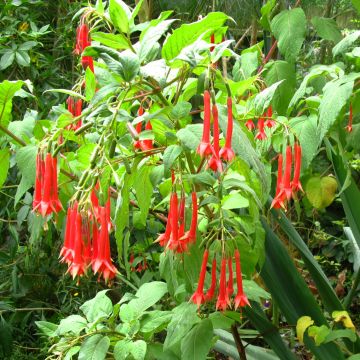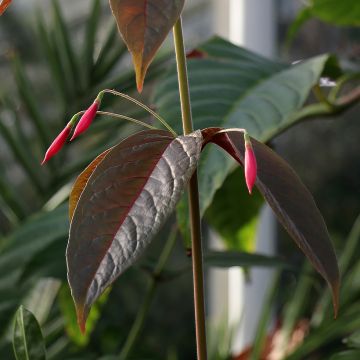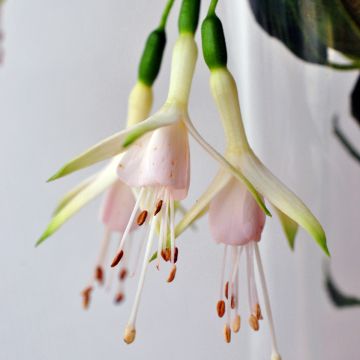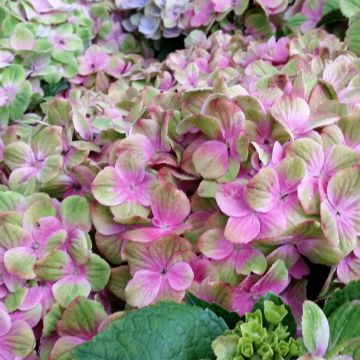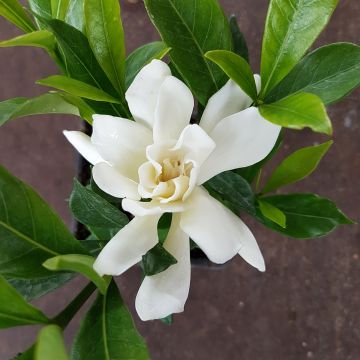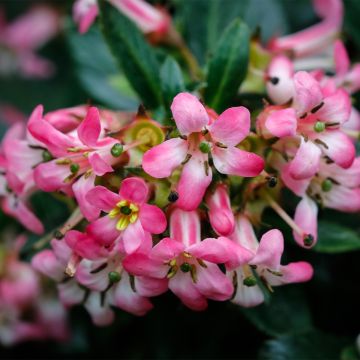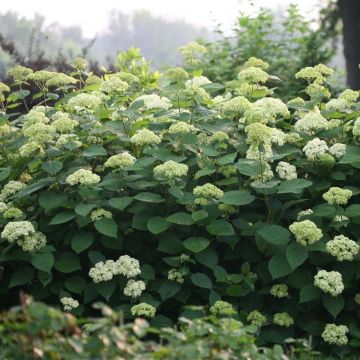

Fuchsia x regia Regal
Fuchsia x regia Regal
Fuchsia x regia Regal
Climbing Fuschsia
Why not try an alternative variety in stock?
View all →This plant carries a 24 months recovery warranty
More information
We guarantee the quality of our plants for a full growing cycle, and will replace at our expense any plant that fails to recover under normal climatic and planting conditions.
From €5.90 for pickup delivery and €6.90 for home delivery
Express home delivery from €8.90.
Does this plant fit my garden?
Set up your Plantfit profile →
Description
The Fuchsia x regia 'Regal' is a small unusual fruit bush, offering both a magnificent summer flowering and edible berries. Its violet and fleshy berries, rich in vitamins, can be enjoyed fresh or transformed into jams and juice. Rather cold-resistant (-10 °C), comfortable in a pot, it is a versatile plant that will enhance the terrace or garden. You will cultivate it in light shade, in a rich, fresh, and light soil. In open ground, this fuchsia survives cold winters by sprouting from the stump in spring.
Fuchsia regia is a botanical species native to Brazil, discovered in the 1980s, belonging to the onagraceae family. Fuchsia 'Regal' is a hybrid of this plant selected for its abundant and high-quality fruiting. It is a compact bush that quickly reaches between 50 cm and 1 m in height, with a similar spread. Its bicolour flowering, made of bright pink and violet flowers, brightens the garden or terrace from June to September. But the real asset of this variety lies in its edible fruits: they are oblong, tender, and juicy berries, seedless, resembling a peanut in shape. When ripe, they are dark purple-black and detach easily. Their flesh has a subtle grape flavor with a slight hint of black pepper. Harvested from late August, these berries are rich in vitamin C. They can be turned into juice, jams, or even used to top pies. The flower petals, also edible, can be added to salads or crystallized to attenuate their slight bitterness.
The foliage of Fuchsia 'Regal' persists in winter as long as it does not freeze. It consists of small oval and elliptical, slightly dentate leaves. They are shiny, in a beautiful dark green. They make a beautiful backdrop for the flowers.
Fuchsia regia 'Regal' will delight amateur gardeners of ornamental and fruit plants. In a pot on a terrace or in open ground, it can be paired with other original small fruit bushes like Dwarf Blackberry 'Lucky Berry', the Dwarf Raspberry 'Ruby Beauty', the Dwarf Mulberry Bonbonberry® ‘Mojo Berry’ and the Climbing Strawberry 'Mount Everest'.
Report an error about the product description
Plant habit
Flowering
Foliage
Botanical data
Fuchsia
x regia
Regal
Onagraceae
Climbing Fuschsia
Fuchsia regia subsp. regal
Cultivar or hybrid
Other Woody Fuchsia
Planting and care
The 'Regal' Fuchsia thrives in partial shade in a fresh, fertile, slightly acidic soil, light and well-drained, retaining moisture in summer. It does not appreciate scorching sun or waterlogged soils in winter. Morning sun is well tolerated. You can add some gravel at the bottom of the planting hole. Mulch in summer to keep the soil slightly moist and save on watering.
Its leaves are deciduous as soon as the temperature drops below -4°C and its stems droop further below -7°C. However, if your climate is harsher (down to -10°C), the stems will not survive, which will not endanger your Fuchsia. You will then prune and protect the stump by mulching or mounding. The stems will regrow vigorously in spring. Prune again if necessary in early spring by removing dry parts. An annual pruning after flowering helps stimulate growth and promote flowering the following year.
Planting period
Intended location
Care
This item has not been reviewed yet - be the first to leave a review about it.
Summer-flowering shrubs
Haven't found what you were looking for?
Hardiness is the lowest winter temperature a plant can endure without suffering serious damage or even dying. However, hardiness is affected by location (a sheltered area, such as a patio), protection (winter cover) and soil type (hardiness is improved by well-drained soil).

Photo Sharing Terms & Conditions
In order to encourage gardeners to interact and share their experiences, Promesse de fleurs offers various media enabling content to be uploaded onto its Site - in particular via the ‘Photo sharing’ module.
The User agrees to refrain from:
- Posting any content that is illegal, prejudicial, insulting, racist, inciteful to hatred, revisionist, contrary to public decency, that infringes on privacy or on the privacy rights of third parties, in particular the publicity rights of persons and goods, intellectual property rights, or the right to privacy.
- Submitting content on behalf of a third party;
- Impersonate the identity of a third party and/or publish any personal information about a third party;
In general, the User undertakes to refrain from any unethical behaviour.
All Content (in particular text, comments, files, images, photos, videos, creative works, etc.), which may be subject to property or intellectual property rights, image or other private rights, shall remain the property of the User, subject to the limited rights granted by the terms of the licence granted by Promesse de fleurs as stated below. Users are at liberty to publish or not to publish such Content on the Site, notably via the ‘Photo Sharing’ facility, and accept that this Content shall be made public and freely accessible, notably on the Internet.
Users further acknowledge, undertake to have ,and guarantee that they hold all necessary rights and permissions to publish such material on the Site, in particular with regard to the legislation in force pertaining to any privacy, property, intellectual property, image, or contractual rights, or rights of any other nature. By publishing such Content on the Site, Users acknowledge accepting full liability as publishers of the Content within the meaning of the law, and grant Promesse de fleurs, free of charge, an inclusive, worldwide licence for the said Content for the entire duration of its publication, including all reproduction, representation, up/downloading, displaying, performing, transmission, and storage rights.
Users also grant permission for their name to be linked to the Content and accept that this link may not always be made available.
By engaging in posting material, Users consent to their Content becoming automatically accessible on the Internet, in particular on other sites and/or blogs and/or web pages of the Promesse de fleurs site, including in particular social pages and the Promesse de fleurs catalogue.
Users may secure the removal of entrusted content free of charge by issuing a simple request via our contact form.
The flowering period indicated on our website applies to countries and regions located in USDA zone 8 (France, the United Kingdom, Ireland, the Netherlands, etc.)
It will vary according to where you live:
- In zones 9 to 10 (Italy, Spain, Greece, etc.), flowering will occur about 2 to 4 weeks earlier.
- In zones 6 to 7 (Germany, Poland, Slovenia, and lower mountainous regions), flowering will be delayed by 2 to 3 weeks.
- In zone 5 (Central Europe, Scandinavia), blooming will be delayed by 3 to 5 weeks.
In temperate climates, pruning of spring-flowering shrubs (forsythia, spireas, etc.) should be done just after flowering.
Pruning of summer-flowering shrubs (Indian Lilac, Perovskia, etc.) can be done in winter or spring.
In cold regions as well as with frost-sensitive plants, avoid pruning too early when severe frosts may still occur.
The planting period indicated on our website applies to countries and regions located in USDA zone 8 (France, United Kingdom, Ireland, Netherlands).
It will vary according to where you live:
- In Mediterranean zones (Marseille, Madrid, Milan, etc.), autumn and winter are the best planting periods.
- In continental zones (Strasbourg, Munich, Vienna, etc.), delay planting by 2 to 3 weeks in spring and bring it forward by 2 to 4 weeks in autumn.
- In mountainous regions (the Alps, Pyrenees, Carpathians, etc.), it is best to plant in late spring (May-June) or late summer (August-September).
The harvesting period indicated on our website applies to countries and regions in USDA zone 8 (France, England, Ireland, the Netherlands).
In colder areas (Scandinavia, Poland, Austria...) fruit and vegetable harvests are likely to be delayed by 3-4 weeks.
In warmer areas (Italy, Spain, Greece, etc.), harvesting will probably take place earlier, depending on weather conditions.
The sowing periods indicated on our website apply to countries and regions within USDA Zone 8 (France, UK, Ireland, Netherlands).
In colder areas (Scandinavia, Poland, Austria...), delay any outdoor sowing by 3-4 weeks, or sow under glass.
In warmer climes (Italy, Spain, Greece, etc.), bring outdoor sowing forward by a few weeks.





































